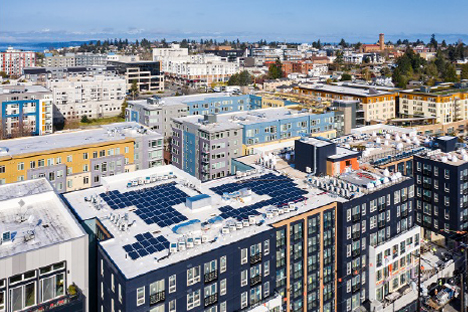In het kader van de Green Deal, heeft de Commissie recent haar strategie gepubliceerd met betrekking tot zonne energie. Om zo haar klimaatdoelstellingen te helpen halen.
‘Zonnedaken’
Deze strategie omvat ondermeer een initiatief met betrekkking tot ‘zonnedaken’, deze zal
eerstdaags worden gepubliceerd.
Met dit intitiatief zullen zonnepanelen verplicht moeten worden geïnstalleerd op:
- Alle openbare gebouwen en nieuwe commerciële gebouwen waarvan de nuttige oppervlakte meer dan 250m2 bedraagt en dit tegen 2026;
- Alle openbare gebouwen en bestaande commerciële gebouwen waarvan de nuttige oppervlakte meer dan 250m2 bedraagt en dit tegen 2027;
- Alle nieuwe residentiële gebouwen tegen 2029;
- Alle nieuwe gebouwen zullen moeten voorzien zijn van de nodige infrastructuur om zonne energie installaties toe te laten, ze zullen ‘zonne-energie-klaar’ moeten zijn.
Tevens zullen de lidstaten verplicht steunprogramma’s moeten opzetten ter bevordering van de installatie van zonne energie op de gebouwen, zowel voor de nieuwbouw als voor renovaties.
La Commission européenne annonce sa stratégie pour le photovoltaïque!
Dans le cadre du Green Deal, la Commission a récemment publié sa stratégie pour l’énergie solaire afin de se donner les moyens d’atteindre ses objectifs climatiques.
Des toits “solaires”
Cette stratégie comprend notamment une initiative sur les ‘toits solaires’ qui sera publiée dans les jours à venir.
Cette initiative devrait rendre obligatoire l’installation de panneaux photovoltaïques sur:
- Tous les bâtiments publics et commerciaux neufs dont la surface utile est supérieure à 250m² d’ici 2026;
- Tous les bâtiments publics et commerciaux existants d’une surface utile supérieure à 250m² d’ici 2027;
- Tous les bâtiments résidentiels neufs d’ici à 2029;
- Tous les bâtiments neufs devront être ‘prêts pour le solaire’, c’est-à-dire conçus pour optimiser le potentiel de production et permettre l’installation fructueuse de technologies solaires.
Par ailleurs, les États membres auront également l’obligation d’établir des programmes de soutien à l’installation de systèmes photovoltaïques intégrés aux bâtiments, tant pour les nouveaux bâtiments que pour les rénovations.







